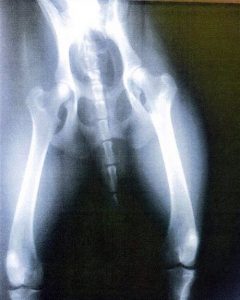
By Gary Thompson
One of the more devastating diagnoses in dogs that people receive is appendicular osteosarcoma, or a primary bone tumor. As someone who sees limping dogs all day, it is far and away the most common cancer I diagnose.
Approximately 80-85 percent of skeletal tumors in dogs are suspected to be osteosarcoma, and it is generally seen between the ages of 7 and 9 years, but in rare cases very young dogs can be affected as well. The exact cause is unknown, but a strong genetic link is suspected because certain breeds like rottweilers, Saint Bernards, Great Danes, mastiffs, and deerhounds are commonly affected.
The most common symptom is unexplained limping, and some dogs will have an obvious swelling at the lower part of the front leg, as the bottom of the radius in the forearm is one of the most common locations. Other areas that are affected are the upper part of the humerus near the shoulder, the upper part of the tibia, and the bottom of the femur around the knee.
Diagnosis is most commonly made through X-rays that show a characteristic appearance of a combination of bone destruction and proliferation in the region of the tumor. Unfortunately, in some dogs the first major symptom might be related to fracture of the diseased bone.
Treatment generally consists of either surgery and drug therapy, or palliative care centered on aggressively managing the pain associated with the tumor, because in most cases the pain can be severe. Since 90 percent of cases have metastasis, or spread of the cancer, at the time of diagnosis all treatment options have to be considered knowing that eventually the cancer will return.
Having said that, many dogs treated for bone cancer can experience excellent quality of life. Surgical options are either amputation of the affected limb or what is called bone-sparing surgery. This surgery is generally limited to tumors of the lower radius, where the cancerous bone is removed and either a custom bone plate or donor bone is placed in the defect.
Bone-sparing procedures have extremely high complication rates and should only be considered in a very select few patients. Any surgical treatment of bone cancer needs to be performed in conjunction with drug therapy because spread of the cancer is expected, and without drug treatment survival times are not improved. These treatments are given via an IV infusion every few weeks and generally are tolerated extremely well in most patients.
With surgery and drug therapy, survival times post-diagnosis average six to twelve months, which may not seem like much, but the quality of life is generally excellent. For those dogs for which surgery is not pursued, aggressive pain management must be considered because the destruction of the bone from the cancer is quite painful.
From the time of initial diagnosis, survival times generally are measured in weeks for patients not treated surgically. Hopefully, osteosarcoma is a diagnosis you will never hear from your veterinarian, but there are options to discuss with your veterinarian so you can decide what is right for you and your dog.








